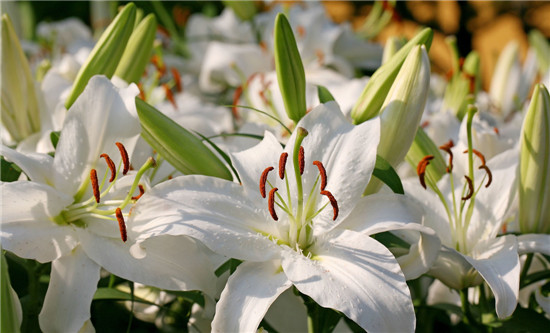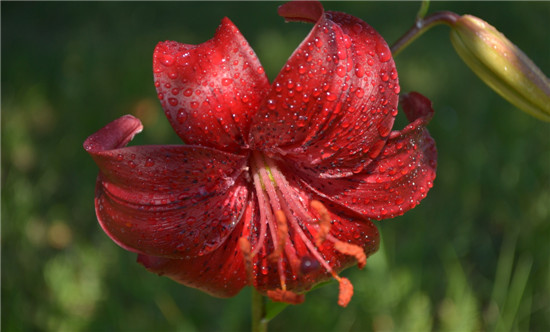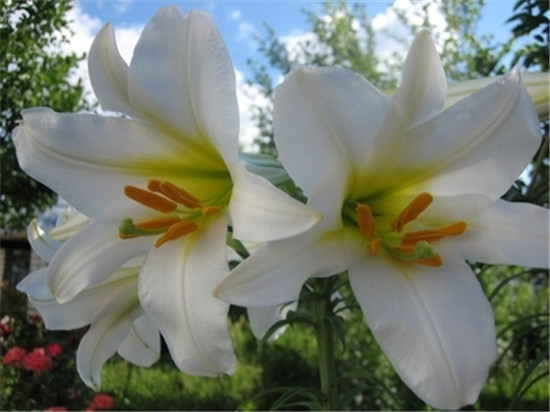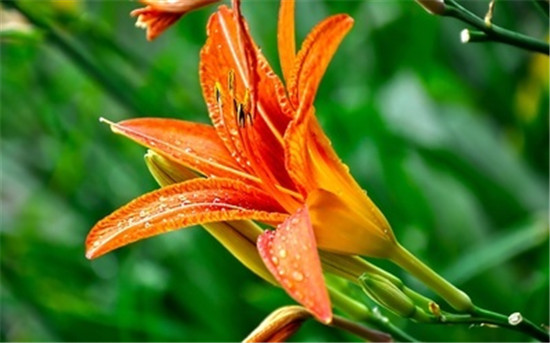What are the effects and functions of Lily?
Lily is one of our common flowers, it not only has a high appreciation value, its medicinal value is as outstanding as its appreciation value, and then let's take a look at the efficacy of lilies.

What are the nutritional values of lilies
Lily, sweet and bitter, flat in nature, entering the heart and lung meridian, has the effect of moistening the lung and relieving cough, nourishing yin and relieving heat, clearing the heart and calming the mind. Single decoction of lily or mixed with other foods and drugs can play a role.
Lily not only contains starch, protein, fat and calcium, phosphorus, iron vitamin B1, B2, C, pantothenic acid, carotene and other nutrients, but also contains some special nutrients, such as colchicine and other alkaloids. These ingredients have a comprehensive effect on the human body, which not only has a good nutritional effect, but also plays a certain role in the prevention and treatment of a variety of seasonal diseases caused by dry climate in autumn.
The use of lilies in traditional Chinese medicine is mainly used in people with chronic lung diseases such as chronic bronchitis or emphysema who often cough or cough for a long time. Lily tastes sweet and slightly bitter, flat. According to "don't record", it is "non-toxic". Indications: moistening the lungs and relieving cough, clearing the heart and calming the mind. Treatment of tuberculosis and chronic cough, coughing up sputum and blood. After the fever, the residual heat is clear, the empty annoyance is frightened and palpitates, the spirit is in a trance. The beriberi is puffy. According to "don't record" records: in addition to edema and abdominal distension, spleen fullness, cold and heat, general pain and milk, cough, stop tears. It can be used to treat lung heat, lung irritability cough, hemoptysis, low fever and deficiency, palpitation and insomnia.

The efficacy of Lily:
Lily has the effect of moistening the lungs and relieving cough, clearing the heart and calming the mind, especially the fresh lily is more sweet and delicious. Lily is especially suitable for people who nourish the lungs and stomach, such as chronic cough, tuberculosis, mouth and tongue sores, dry mouth, bad breath, and some palpitations can also be eaten in moderation. However, due to the coolness of lilies, patients with cold stomach use less. It is used for cough and hemoptysis due to lung dryness or yin deficiency, often with chuanbei. For febrile ☆ prohibition of ☆ disease after the afterheat is not clear, vexed insomnia, trance, often equipped with Rehmannia.
Alias: fine leaf lily, line leaf lily, musk lily, rolling leaf lily, white flower lily, white lily, medicine lily, mountain lily, family lily, wild lily, vegetable lily, dried lily, Sichuan lily, sweet lily, big lily, new lily, rock lily, Hongyan lily, lily garlic, garlic proline, trumpet root, leek, heavy, heavy, heavy box, atrium, Moro, Qiangli, Qiangfei Zhongfeng flower, night flower root, roll lotus root, lantern umbrella root, loose lotus root, du lily, red, every flower. Nature: sweet; slightly bitter; slightly cold.

Meridian: heart meridian; lung meridian.
Efficacy: nourish yin and moisten the lungs; clear the heart and calm the mind.
Indications: Yin deficiency and chronic cough; blood in sputum; late stage of fever; deficiency, palpitation, insomnia and dreaminess caused by incomplete heat or failure of emotion; carbuncle swelling; dampness sore.
Usage: oral administration: fried soup, 6-12g; or into pills, powder; can also be steamed, boiled porridge. External use: appropriate amount, tamping.
The role of lilies
1. Antitussive and expectorant effect
1. Antitussive effect mice were induced by SO2 to observe its antitussive effect. All of them have obvious antitussive effect.
2. The expectorant effect was determined by phenol red colorimetry. Finally, the trachea was washed with 0.5mlNaHCO3. The absorbance was measured at 546nm, and the amount of phenol red excreted from the trachea was calculated from the phenol red standard curve. The results are shown in Table 3. All of them have significant expectorant effect.
2. sedative effect
After stopping eating for 8 hours, the mice were respectively ig lily 20g/kg, wild jujube kernel was used as positive control, normal saline was used as blank, and ip pentobarbital sodium 40mg/kg was given for 30 minutes. The time from disappearance of righting reflex to recovery was used as sleep index. At the same time, the effect on the sleep rate of subthreshold dose of pentobarbital sodium was observed. All of them can significantly increase the sleep time of pentobarbital sodium and the sleep rate of subthreshold dose, suggesting that it has obvious sedative effect.

Third, the effect of nourishing yin and moistening the lung
1. The swimming experiment of lung qi deficiency model showed that lily and lily were given 10g/kg dose of ig in mice, and compared with astragalus (10g/kg), the swimming time was significantly prolonged, the P values of the three were all.
2. Hypoxia tolerance test of hyperthyroidism yin deficiency model, the mouse model was made with thyroxine 0.3mg/. Results Lily plus thyroxine group and Curcuma plus thyroxine group significantly prolonged the hypoxia tolerance of mice, and their P values were P
3. In the load swimming test of Yin deficiency model induced by adrenocortical hormone, male mice were divided into normal saline group, prednisolone (40mg/kg/) modeling group and drug (ig10g/kg) enhanced pine group. Results Lily had a significant protective effect on adrenocortical failure (P
These are all the contents of the efficacy and function of lilies that I have summarized for you. I hope this article can help you. Please continue to follow us.
I hope this article can help you all. Please continue to follow us.
Related
- Wuhan Hospital Iron Tree Blooming Result Was Instantly Frightened by the Gardener Master
- Which variety of camellia is the most fragrant and best? Which one do you like best?
- What is the small blue coat, the breeding methods and matters needing attention of the succulent plant
- Dormancy time and maintenance management of succulent plants during dormancy
- Minas succulent how to raise, Minas succulent plant pictures
- What are the varieties of winter succulent plants
- How to raise succulent plants in twelve rolls? let's take a look at some experience of breeding twelve rolls.
- Attention should be paid to water control for succulent plants during dormant period (winter and summer)
- Watering experience of twelve rolls of succulent plants
- Techniques for fertilizing succulent plants. An article will let you know how to fertilize succulent plants.



